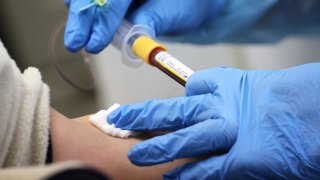
- Blood is big business in the United States, making up 2.69% of the country's exports, according to the Census Bureau.
- Since there's no substitute for human blood, demand can be hard to meet. During the pandemic, a blood shortage prompted the FDA to revisit its ban on donations from men who have sex with men.
- In the U.S., it's legal to compensate people for their blood donation, creating a unique economy where for some people donating plasma is an economic coping mechanism.
In America, blood means big business. The North American blood market was valued at $3.3 billion in 2021, according to Global Market Insights Inc.
Blood makes up 2.69% of U.S. exports, according to the Census Bureau.
Since there is no substitute for human blood, demand can be hard to meet.
Get Southern California news, weather forecasts and entertainment stories to your inbox. Sign up for NBC LA newsletters.
During the Covid pandemic, the Red Cross announced its first-ever national blood shortage crisis.
"There are still sporadic shortages," Dr. Claudia Cohn, chief medical officer of the Association for the Advancement of Blood & Biotherapies, told CNBC.
An early pandemic shortage prompted the FDA to loosen its restriction, which stems from the 1980s AIDS crisis, on accepting blood donations from men who have sex with men. Advocates want the FDA to follow the science and do away with the ban altogether, as have countries such as Italy and Spain.
Money Report
"There is still government policy that stigmatizes gay and bisexual and other men who have sex with men and carries forward this false notion that there is something inherently diseased about being gay," Jason Cianciotto, vice president of communications and public policy at Gay Men's Health Crisis, told CNBC.
A 2014 report found that allowing this community equal access to donating blood could increase the blood supply by 2% to 4% every year.
Grifols, CSL Plasma, Takeda's Biolife and Octapharma are huge players in the blood collection space, particularly plasma, and donors are compensated.
"Plasma donation [centers] are advertising $900 for your first month giving plasma," Analidis Ochoa, a doctoral candidate studying social work and sociology at the University of Michigan, told CNBC. "Then it goes down. Usually people can make $30 to $50 each time they go."
In most countries, blood donation for compensation is banned, but not in the United States. So, the U.S. supplies 70% of the world's plasma, according to the Niskanen Center.
"What myself and colleagues have worked on is mapping out the location of plasma centers and seeing if there's a correlation between the address of the center and the poverty level of the area. And what we have found is that they are, in fact, overrepresented in high-poverty areas," Ochoa said.
She said that plasma donation for compensation is becoming an economic coping mechanism.
"The fact that I got rewarded for donating has kept me donating, because I couldn't make it otherwise. I couldn't buy gas. I couldn't pay my car insurance," Teresa Clark, a plasma donor, told CNBC. "I can make $650 to $700 a month ... and that helps a lot when you're on a fixed income."
Watch the video above to learn more about how the weird economy of blood works, why the U.S. is such a major player and what makes plasma so valuable.






